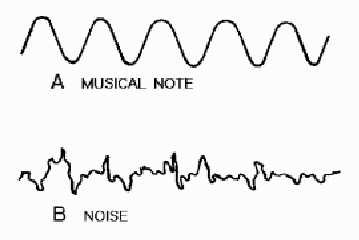1-20
Figure 1-13.—Musical sound versus noise.
Sound has three basic characteristics: pitch, intensity, and quality. Each of these three characteristics
is associated with one of the properties of the source or the type of waves which it produces. The pitch
depends upon the frequency of the waves; the intensity depends upon the amplitude of the waves; and the
quality depends upon the form of the waves. With the proper combination of these characteristics, the
tone is pleasant to the ear. With the wrong combination, the sound quality turns into noise.
The Pitch of Sound
The term PITCH is used to describe the frequency of a sound. An object that vibrates many times per
second produces a sound with a high pitch, as with a police whistle. The slow vibrations of the heavier
strings of a violin cause a low-pitched sound. Thus, the frequency of the wave determines pitch. When the
frequency is low, sound waves are long; when it is high, the waves are short. A sound can be so high in
frequency that the waves reaching the ear cannot be heard. Likewise, some frequencies are so low that the
eardrums do not convert them into sound. The range of sound that the human ear can detect varies with
each individual.
The Intensity of Sound
The intensity of sound, at a given distance, depends upon the amplitude of the waves. Thus, a tuning
fork gives out more energy in the form of sound when struck hard than when struck gently. You should
remember that when a tuning fork is struck, the sound is omnidirectional (heard in all directions), because
the sound waves spread out in all directions, as shown in figure 1-14. You can see from the figure that as
the distance between the waves and the sound source increases, the energy in each wave spreads over a
greater area; hence, the intensity of the sound decreases. The speaking tubes sometimes used aboard a
ship prevent the sound waves from spreading in all directions by concentrating them in one desired
direction (unidirectional), producing greater intensity. Therefore, the sound is heard almost at its original
intensity at the opposite end of the speaking tube. The unidirectional megaphone and the directional
loudspeaker also prevent sound waves from spreading in all directions.


